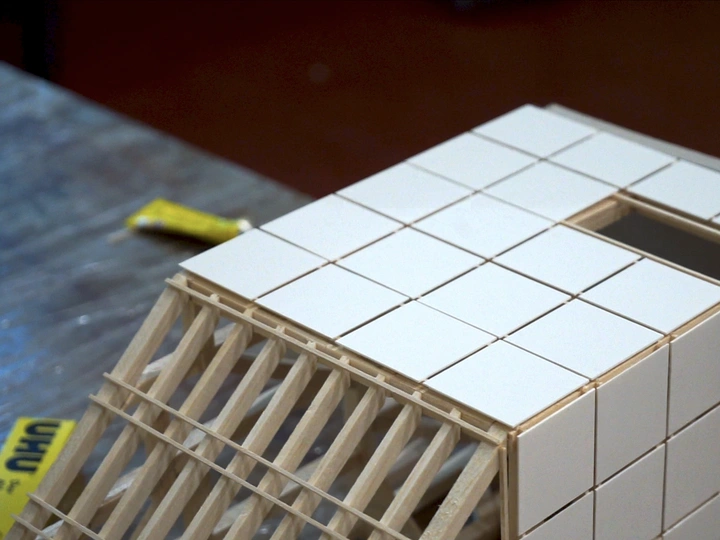Stick-on Bricks and the Phenomenology of Flatness

Gloria Regonesi
Studio Regolith converges the trajectories of Estudio ESSE and Gloria Regonesi. Acting as a vehicle for multidisciplinary exploration, it dismantles outdated infrastructures of architectural communication and constructs in their place documentation that reflects nuanced ambiguities of spatial experience. Studio Regolith is a cinematic collider where architectural critique and experimental filmmaking jostle over perceptions and representations of the physical, the ephemeral and the more-than-human alike. Restlessly probing at the artificial experience of our built reality, the studio is a unique environment of academic rigour and augmented post-absurdity.
Sam Eadington is co-founder of architecture, art and research practice Estudio ESSE, Lecturer in Architecture at the Grenfell Baines Institute of Architecture, UK, and Programme Tutor of Interior and Spatial Design at the Open College of Arts. His practice and pedagogy are propelled by a ‘thinking through making’ approach to architecture that embeds contextual analysis and response at its core. Estudio ESSE has completed projects in Spain, Germany and the UK and had its work exhibited across Europe. Sam’s award winning self-build designs are known for their refined reconciliation of pragmatism with imagination, playfulness and provocation.
Gloria Regonesi is a filmmaker and digital educator whose experimental films, video essays and documentaries have been screened across Italy, Germany and the UK. Her works examine our perception of space and its intersection with identity, belonging, and social inequality. At the centre of her work often lies the emotional resonance of places, challenging us to reconsider how we understand reality and how we interpret and interact with the environment. Observation of capitalism and its impact on the social and natural environment underpin her audiovisual pieces, characterised by a sense of humour and an innovative approach to filmmaking.
An ever-growing video-based research archive that explores the prevalent flatness in contemporary architecture and its impact on society and the environment. We examine this contrived flatness as it converges with the wider cultural shift towards digital technology, influencing architectural design, human perception of space, as well as more-than-human experiences of our built environs. Using filmmaking as research, we seek to question and innovate how we communicate architecture, particularly through audiovisual means.
Digitalised design and manufacturing have led to a flattening and artificiality in our experience of built environments. This trend threatens to erode our ability to create and represent our individual and collective identities through material culture. Instead, we face the imposition of culturally homogenising ideologies upon societies across the globe.
Combining the media of physical modelmaking and film, this project provokes a re-evaluation of architectural design principles and encourages a more profound connection between making, architecture, human experience and endangered ecologies in the face of the challenges of the Anthropocene era.
In a world grappling with the loss of biodiversity and the degradation of ecosystems, we believe a trans-species concept of porosity holds tremendous potential. Through our interdisciplinary approach, blending art, architecture, and film, we aspire to catalyse meaningful change in our built environments and contribute to the growing body of knowledge exploring the intersections between human activities and ecological concerns.
Within the framework of this project, we conduct talks, screenings, and educational initiatives and workshops bridging film, research and architecture. Our project output will grow as we broaden our research to encompass a multitude of cities and investigate further aspects of life and society impacted by the concept of artificiality and flatness.